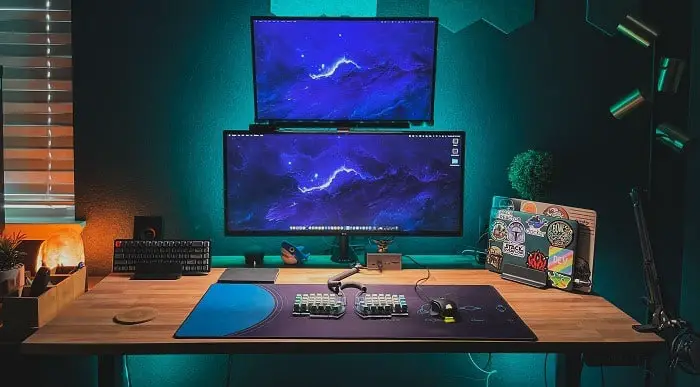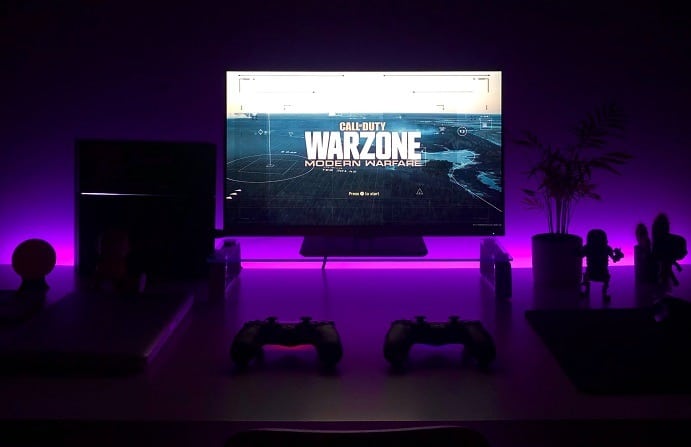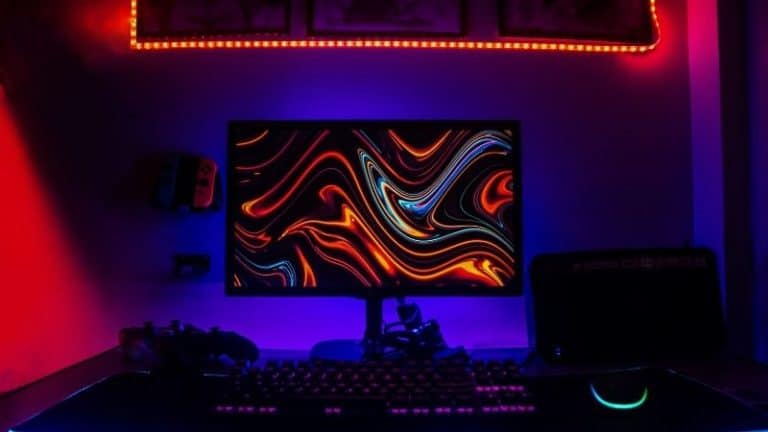Computer monitors have come a long way since their early days as cathode ray tubes. The technology has improved so much in the last few decades that many people are now surprised to learn that computer monitors even have an expiration date.
However, even the most durable monitors will eventually wear down one day. But the question is, how long does a computer monitor last? The lifespan of computer monitors can vary depending on several factors, but in general, a monitor should last for 5 to 7 years with normal use.
If you’re like most people, your computer monitor is a constant companion on your desk. So, when you’re concerned about the lifespan of your computer monitor, it’s crucial to know how to conserve that lifespan or even extend it. Let’s begin.
How Long Does A Computer Monitor Last?
With the development of modern technologies, different types of monitors have been introduced over the past few years. Each type of computer monitor has a different lifespan. Here we’re going to discuss the lifespan of the four most popular types of computer monitors. Hopefully, you just have got one of them.
Lifespan of LCD Monitors
LED monitors have an average lifespan of about 40,000 hours, and this is equal to 10 to 20 years of use. An LCD monitor is in use eight hours a day which can be put on a par with the preceding generation of CRTs, and considerably longer than Plasmas.
However, it’s not long when compared with the lifetime of modern LED monitors. These monitors use two pieces of liquid crystal vapor sandwiched between two separate layers of polarizing material as a way to run their light source.
For instance, if you leave the power on for a long time after buying a monitor, you can use this artifact for up to 1825 days without burning it, and it lasts about 3 to 5 years.
Generally, most people choose to shut down the computer when not in use. In that case, your LCD monitor will last 10-15 years on an average usage of 12 hours per day.
Lifespan of LED Monitors
LED monitors last approximately 20 years, which is somewhere between 80,000 and 120,000 hours. That’s the approximate lifespan when typical use is around eight hours every day.
However, materials and manufacturers can make a huge difference in the lifespan of LED monitors.
At present, companies that are manufacturing and selling the latest LED monitors are introducing screens using cutting-edge technology and the latest display materials.
Among other things, these monitors are more efficient than LCD screens and CRTs, because they emit brighter and more vivid colors However, they are more expensive compared to their nearby competitors like LCD.
From mild inconvenience to a major failure, the LED monitor’s lifespan can be drastically affected by the intensity of use, temperature range, and brightness.
Harsher conditions with frequent use causing extreme temperature fluctuations and an excessive amount of light can shorten the monitor’s lifespan significantly.
That’s why it is essential to uncover definite and stable LED supplies to guarantee optimum functionality and long-term operation. It’s crucial that LED supplies are appropriately modified and maintained to promote optimum operation and lifespan.
Lifespan of CRT Monitor
CRT screens may last anywhere from 20,000 to 30,000 hours if operated for 8 hours per day. This implies a lifespan of 10 years if the monitor is operated each day. After this point, service or repair is required.
CRT monitors are more prone to image retention, or the tendency for images to remain on the screen after being displayed. This can be caused by dust or other particles on the monitor’s surface, which can block light and cause the pixels to stay active.
They’re also more likely to experience electrical noise and malfunctions due to their outdated design. This can cause signals to become distorted, which can lead to image retention or other problems with the monitor.
If you’ve ever owned an old CRT monitor, you’re probably quite familiar with how the monitors tend to suffer from frequent overheating problems.
Lifespan of OLED Monitor
Life expectancy for an OLED monitor is mainly determined by how you use your panels. OLEDs use organic compounds as their pixels.
If you spend a lot of time playing games or using it for 12 hours out of every day, the organic components of the panel will be degraded over time.
Additionally, OLED monitors require less power to operate than traditional monitors, they’re more prone to being shut down by electrical interference or even accidental flicks of a finger. These result in a shorter lifespan of OLED panels.
In the case of OLED lifespan, there is no definite evidence about the exact service life.
However, based on the findings and reports, the lifespan of the OLED monitor could be in excess of 100,000 hours. And it could extend 8–15 years when the panel is used 8 hours per day.

Factors That Influence the Lifespan of Computer Monitors
Even though computer monitors come with a certain lifespan, it doesn’t seem to be constant every time. The key reason behind this is the influence of other factors. So, what factors influence the lifespan of computer monitors?
While there are many factors that influence the lifespan of computer monitors, some of the most important ones include:
- Durability of Components
A monitor’s lifespan is greatly influenced by the durability of its components. This is because, components that are not durable will fail sooner, which can lead to an early replacement and a shortened lifespan for the monitor. Durable components will last longer and require less maintenance.
There are a few things that determine the durability of a monitor’s components, such as materials used in the construction of the display panel, assembly techniques, environmental conditions, and quality control measures.
For instance, If your monitor makes use of premium quality electronic components, utilizes state-of-the-art technology like first-rate 4K monitors, and features an eye-catching display panel, you should feel calm, as the screen will be functioning well in coming years.
- Hours of Usage and Screen On Time
While there are no hard and fast rules, it is generally accepted that monitors that are used more frequently will have shorter lifespans than those used less often.
There are some factors involved in determining how much use a monitor can take before it starts to suffer, but overall, it seems as though most monitors can be expected to last around 3-5 years if they’re used moderately.
In case, you use your monitor for eight hours or longer every single day, the life expectancy will be reduced. In contrast, if you use the monitor for just a couple of hours per day, then the monitor is likely to last beyond the initial life expectancy estimation.
At the same time, the screen on time also significantly influences the overall lifespan of a monitor. Many people tend to turn on the monitor and start working. Then, they forget to turn off the monitor, or maybe they leave it on all night long.
This can damage a monitor over time because the screen is constantly exposed to light and heat.
- Care and Maintenance
A monitor’s lifespan is largely determined by how well it is cared for and maintained. Lack of proper care and maintenance can lead your monitor to a shorter lifespan due to deteriorating performance, screen issues, and even overheating.
While well-maintained monitors can last for years with proper care. The ideal care and maintenance schedule for a monitor includes how often the screen should be cleaned, whether the monitor should be placed in a warm or cold environment, and if it should be used with a laptop or desktop computer.

How to Identify Your Computer Monitor Is Dying
As we have mentioned several times, the lifespan of a monitor can vary due to the influence of different factors. So, it’s impossible to say exactly when your monitor will end and need replacement.
However, there are some common signs that indicate a monitor is dying or need to be replaced. Let’s have a closer look:
- Dimming Images
When you first noticed the decrease in brightness, you may have assumed that your computer monitor was simply getting old and needed to be replaced.
But if the image on the screen is gradually becoming darker, there may be a much more serious problem at hand.
A computer monitor’s image will gradually dim over time as the pixels in the display become less effective at creating an image. The longer a monitor is used, the sooner this process will start.
Eventually, the image on the screen will be completely illegible. If you’re experiencing reduced image quality and your computer monitor is aging, it may be time to replace it.
- Dead Pixels
Dead pixels are tiny black spots that can appear on your computer monitor, indicating that the monitor is wearing down and may soon need to be replaced.
A dead pixel may look like a small black dot, but it can also be a dark spot or streak on the screen.
If you experience a lot of dead pixels, it may be best to get a new monitor. Dead pixels are often an indicator of other problems with the computer, so it’s important to have them checked out by a professional if they’re becoming an issue.
- Monitor Burn-in
Monitor burn-in can indicate that your computer monitor is losing its vibrancy and eventually dying. This can be caused by extended use of the monitor or displaying a series of very bright colors or images.
Over time, the pixels on the screen start to “burn” and become faded. The more often you use a certain image, the faster it will become burned in.
This can lead to decreased viewing comfort and accuracy, as well as headaches and eyestrain. To avoid monitor burn-in, limit your screen time to 30 minutes or less per day.
- Image Distortion
Everything on the screen appears to be relatively close to you unless there is something wrong with the image itself – like image distortion.
When a monitor begins to show signs of age, its pixels start to lose their color and contrast, which can lead to distorted images.
In this case, you’ll notice the picture’s dimensions are not accurate or consistent. For instance, if one part of the image is taller than another part or if one part of the picture has more colors than another part.
When your computer screen looks distorted, it might be time to replace your monitor. Image distortion indicates that the monitor is nearing its end, and will likely need to be replaced soon.
- Random Shutdown
If you’re noticing more and more shutdowns of your computer, it may be time to invest in a new monitor. A “random shutdown” is a common symptom of a failing monitor and can indicate that your screen is wearing out or even dead.
Technically, a failing monitor can cause power fluctuations that affect the rest of your computer, causing shutdowns and other problems. Replace the monitor if the problem continues, and you’ll save yourself some trouble and money down the road.

Tips to Extend Your Computer Monitor Lifetime
The life of a computer monitor is no different from that of a smartphone, TV, or car. With regular usage, all electronics reach the end of their useful lives and require replacement. The only way to save some extra bucks is to try to extend the lifespan.
But how? Let’s see:
- Keep A Clean And Safe Workspace
Keep your workstation area tidy and clean so that your computer’s life span can be extended. Dust and debris can accumulate on the screen over time, causing the monitor to malfunction or even completely stop working.
For this, you have to ensure that anything that can potentially harm your computer monitor is not next to it.
In addition, try to make sure that your tabletop is made of sturdy material and isn’t being moved about. You may even want to tape it into place to prevent it from being knocked over.
- Don’t Block Air Vents
Modern computer monitors are made from solid-state materials. Thus, they can be damaged under excessive stress. Most of the monitors have many ventilation holes to prevent overheating, but they may be blocked if your workstation has various items.
Be sure to look at the outlets regularly to ensure that they are unobstructed. Dirt and dust may go onto such outlets, so be sure to clean your monitor’s air vents accordingly.
- Incorporate a Surge Protector
If you’re plugging in your monitor directly to a wall outlet, the variations in electrical current might cause problems with your screen’s components.
That means shortened lifespan. In such moments, using a surge protector may significantly extend the life of your display.
Surge protectors, due to their inherent design, are designed to protect sensitive electronic devices from electrical fluctuations.
- Maintain Low Brightness Level
If you need to boost the monitor s brightness, you do not need to set it to the highest level. Rather, lower it to a level that you prefer and then adjust the color and gamma parameters to raise the monitor efficiency.
Monitors that are exposed to too bright of a setting will overheat their bulbs more quickly, which will ultimately lower the display s lifespan.
- Use Black Screen Saver
To prevent accumulating monitor strain and prolonging the life of LCD bulbs of the monitor, try to use a solid black screen saver, rather than something more detailed.
You can set the computer screen saver to something simple instead of a more complex and colorful visual. This could also help reduce the burn-in effect, while also making this more effective.
FAQs
- How often should you replace your computer monitor?
There is no set answer to this question as it largely depends on your usage and habits. Generally, most people replace their computer monitors every 3-5 years.
- Can a monitor last 10 years?
There is no definitive answer to this question as it depends on a variety of factors, including the quality of the monitor and how often it is used. Some monitors like LCDs may last for up to 10 years, while others may only last for a few years.
- What does it look like when a monitor dies?
A monitor dies when its power supply fails. When the power supply fails, the monitor’s electronics are unable to operate and the screen turns black.
- Which monitor brand is most reliable?
There is no single monitor brand that is more reliable than the others. However, some brands are known to be more reliable than others. Some of the more reliable brands include Acer, Dell, HP, and Lenovo.
- Why is the monitor laggy?
There are a few potential causes of laggy or slow-moving monitors. One is that the graphics card may not be powerful enough to handle the graphical demands of the game or application being played. Another possibility is that the monitor itself may not have the processing power or bandwidth to keep up with the action on-screen.
Final Words
Still thinking, how long does a computer monitor last? Hopefully not, as we’ve clarified bit by bit. However, before we leave, we should remind you of something again.
If you’re not using your monitor, be sure to shut it off completely to extend its life. Additionally, keep your monitor clean and free from scratches or smudges. Doing these things will help your computer monitor last longer and function more efficiently.

Hello Good People! This is Pavel and Welcome to PC Delight!
I’m an Electronics Engineer by profession with a passion for Gaming & PC builds. When I came up with the idea for PC Delight, it was my goal to share & offer the very best PC building ideas to tech-loving people like myself.
Since my school days, I’ve been just addicted to gaming & PCs. That leads me to experiment with various ways around the very niche, resulting in great productivity. And I’m here to share those practical experiences. So that next time you start some experiment with your PC builds or struggle to cope with a certain game, I’m here with the solutions. With these philosophies, I started my journey in 2017 and just kept going.
